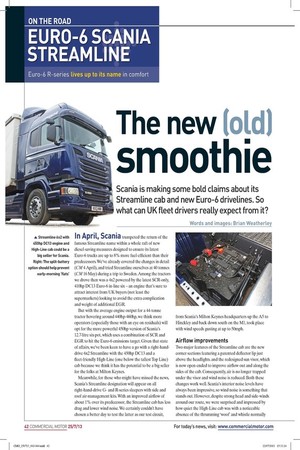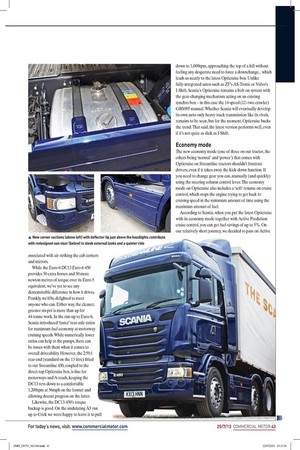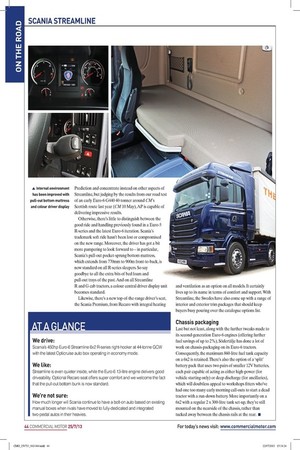ON THE ROAD EURO-6 SCAN IA STREAMLINE Euro-6 R-series lives
Page 36

Page 37

Page 38

If you've noticed an error in this article please click here to report it so we can fix it.
up to its name in comfort The new foy:1) smoothie Scania is making some bold claims about its Streamline cab and new Euro-6 drivelines. So what can UK fleet drivers really expect from it?
Words and images: Brian WeatherLey In April, Scania trumpeted the return of the famous Streamline name within a whole raft of new diesel-saving measures designed to ensure its latest Euro-6 trucks are up to 8% more fuel-efficient than their predecessors. We've already covered the changes in detail (CM 4 April), and tried Streamline ourselves at 40 tonnes (CM 16 May) during a trip to Sweden. Among the tractors we drove then was a 4x2 powered by the latest SCR-only, 410hp DC13 Euro-6 in-line six — an engine that's sure to attract interest from UK buyers (not least the supermarkets) looking to avoid the extra complication and weight of additional EGR.
But with the average engine output for a 44-tonne tractor hovering around 440hp-460hp, we think more operators (especially those with an eye on residuals) will opt for the more powerful 450hp version of Scania's 12.7-litre six-pot, which uses a combination of SCR and EGR to hit the Euro-6 emissions target. Given that state of affairs, we've been keen to have a go with a right-handdrive 6x2 Streamline with the 450hp DC13 and a fleet-friendly High-Line (one below the tallest Top Line) cab because we think it has the potential to be a big seller for the folks at Milton Keynes.
Meanwhile, for those who might have missed the news, Scania's Streamline designation will appear on all right-hand-drive Gand R-series sleepers with side and roof air-management kits. With an improved airflow of about 1% over its predecessor, the Streamline cab has less drag and lower wind noise. We certainly couldn't have chosen a better day to test the latter as our test circuit, from Scania's Milton Keynes headquarters up the A5 to Hinckley and back down south on the Ml, took place with wind speeds gusting at up to 50mph.
Airflow improvements Two major features of the Streamline cab are the new corner sections featuring a patented deflector lip just above the headlights, and the redesigned sun visor, which is now open-ended to improve airflow out and along the sides of the cab. Consequently, air is no longer trapped under the visor and wind noise is reduced. Both these changes work well. Scania's interior noise levels have always been impressive, so wind noise is something that stands out. However, despite strong head and side-winds around our route, we were surprised and impressed by how quiet the High-Line cab was with a noticeable absence of the thrumming 'woof' and whistle normally associated with air striking the cab corners and mirrors.
While the Euro-6 DC13 Euro-6 450 provides 50 extra horses and 50 more newton metres of torque over its Euro-5 equivalent, we've yet to see any demonstrable difference in how it drives. Frankly, we'd be delighted to meet anyone who can. Either way, the cleaner, greener six-pot is more than up for 44-tonne work. In the run-up to Euro-6, Scania introduced 'faster' rear-axle ratios for maximum fuel economy at motorway cruising speeds. While numerically lower ratios can help at the pumps, there can be issues with them when it comes to overall driveability. However, the 2:59:1 rear-end (standard on the 13-litre) fitted to our Streamline 450, coupled to the direct-top Opticruise box, is fine for motorways and A-roads, keeping the DC13 revs down to a comfortable 1,200rpm at 56mph on the former and allowing decent progress on the latter.
Likewise, the DC13-450's torque backup is good. On the undulating AS run up to Crick we were happy to leave it to pull down to 1,000rpm, approaching the top of a hill without feeling any desperate need to force a downchange... which leads us neatly to the latest Opticruise box. Unlike fully-integrated autos such as ZF's AS-Tronic or Volvo's I-Shift, Scania's Opticruise remains a bolt-on system with the gear-changing mechanism acting on an existing synchro box — in this case the 14-speed (12+two crawler) GRS905 manual. Whether Scania will eventually develop its own auto-only heavy truck transmission like its rivals, remains to be seen, but for the moment, Opticruise bucks the trend. That said, the latest version performs well, even if it's not quite as slick as I-Shift.
Economy mode The new economy mode (one of three on our tractor, the others being 'normal' and 'power') that comes with Opticruise on Streamline tractors shouldn't frustrate drivers, even if it takes away the kick-down function. If you need to change gear you can, manually (and quickly) using the steering column control lever. The economy mode on Opticruise also includes a 'soft' resume on cruise control, which stops the engine trying to get back to cruising speed in the minimum amount of time using the maximum amount of fuel.
According to Scania, when you put the latest Opticruise with its economy mode together with Active Prediction cruise control, you can get fuel savings of up to 5%. On our relatively short journey, we decided to pass on Active Prediction and concentrate instead on other aspects of Streamline, but judging by the results from our road test of an early Euro-6 G440 40-tonner around CM's Scottish route last year (CM 10 May), AP is capable of delivering impressive results.
Otherwise, there's little to distinguish between the good ride and handling previously found in a Euro-5 R-series and the latest Euro-6 iteration. Scania's trademark soft ride hasn't been lost or compromised on the new range. Moreover, the driver has got a bit more pampering to look forward to — in particular, Scania's pull-out pocket-sprung bottom mattress, which extends from 770mm to 900m front-to-back, is now standard on all R-series sleepers. So say goodbye to all the extra bits of bed foam and pull-out trays of the past. And on all Streamline R and G cab tractors, a colour central driver display unit becomes standard.
Likewise, there's a new top-of-the-range driver's seat, the Scania Premium, from Recaro with integral heating and ventilation as an option on all models. It certainly lives up to its name in terms of comfort and support. With Streamline, the Swedes have also come up with a range of interior and exterior trim packages that should keep buyers busy pouring over the catalogue options list.
Chassis packaging Last but not least, along with the further tweaks made to its second-generation Euro-6 engines (offering further fuel savings of up to 2%), Sodertfille has done a lot of work on chassis-packaging on its Euro-6 tractors. Consequently, the maximum 860-litre fuel tank capacity on a 6x2 is retained. There's also the option of a 'split' battery pack that uses two pairs of smaller 12V batteries, each pair capable of acting as either high-power (for vehicle starting only) or deep discharge (for ancillaries), which will doubtless appeal to workshops fitters who've had one too many early morning call-outs to start a dead tractor with a run-down battery. More importantly on a 6x2 with a regular 2 x 300-litre tank set-up, they're still mounted on the nearside of the chassis, rather than tucked away between the chassis rails at the rear. • We drive: Scania's 450hp Euro-6 Streamline 6x2 R-series right-hooker at 44-tonne GCW with the latest Opticruise auto box operating in economy mode.
We like: Streamline is even quieter inside, while the Euro-6 13-litre engine delivers good driveability. Optional Recaro seat offers super comfort and we welcome the fact that the pull-out bottom bunk is now standard.
We're not sure: How much longer will Scania continue to have a bolt-on auto based on existing manual boxes when rivals have moved to fully-dedicated and integrated two-pedal autos in their heavies.










































